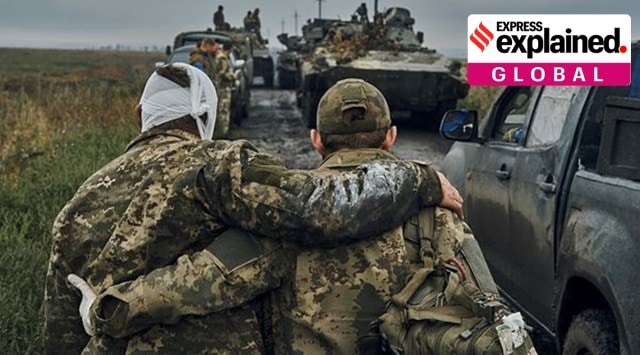How Ukraine scripted its rapid counter-attack
The current counter-offensive by Ukraine is unfolding in two areas — the Kharkiv region in the east, and the southern Kherson region.
 A Ukrainian soldier helps a wounded fellow soldier on the road in the freed territory in the Kharkiv region, Ukraine, Monday, Sept. 12, 2022. (AP/PTI)
A Ukrainian soldier helps a wounded fellow soldier on the road in the freed territory in the Kharkiv region, Ukraine, Monday, Sept. 12, 2022. (AP/PTI)President Volodymyr ZelenskyY on Monday said that Ukrainian forces have retaken 6,000 sq km of Russian-held territory since the beginning of September. The claim came amid Russia conceding a pullback from key cities in the Kharkiv region.
Ukraine’s lightning gains
The current counter-offensive by Ukraine is unfolding in two areas — the Kharkiv region in the east, and the southern Kherson region.
In the Kharkiv region, Russian troops have retreated from Balakliya, Izium and Kupiansk. Both Izium and Kupiansk were key logistics centres being used by the Russian forces.
Ukrainian troops entered Kupiansk — a key rail hub — on Saturday, and within hours captured Izium, which is considered the gateway to Donbas region, a Russian-speaking area whose complete capture has been Russia’s key war aim since the beginning of the conflict.
After capturing Izium in April, Russia was using it as a launchpad for carrying out attacks in the Donbas region. It was, in fact, Moscow’s main bastion — an operation and command centre — next to a major frontline in the war. Kupiansk was the key railway station supplying Izium formations.
US, UK in war room planning
While the gains have taken the world by surprise, the war room planning for the counter-offensive began in summer. According to The New York Times, the initial plan to recapture Kherson was revised, and replaced with a new one to retake territory before the first snow. Backed by intelligence inputs from the US and the UK, it was decided to mount two offensives instead of a single, large counter-attack, The NYT said. The report said that a detailed list of weapons — including the High Mobility Artillery Rocket System (HIMARS) and satellite-guided GMLRS rockets — was sent to the US in order to ensure the plan’s success.
In an interview to The NYT, Pentagon’s policy chief Colin Kahl said: “Set of exercises suggested that certain avenues for a counteroffensive were likely to be more successful than others. We provided that advice, and then the Ukrainians internalized that and made their own decision.” Kahl added the Russians had relocated a lot of their best forces down to the south for the other Ukrainian counter-offensive, leaving pockets of Russian military “a little more brittle than they appeared on paper”.
Russia on the defensive
The recent gains are the biggest battlefield successes for Ukraine since blocking the Russian assault to seize Kyiv.
While Russia has claimed that it has pulled back its forces to re-group and concentrate on Donetsk, the claim is similar to the reasoning that Moscow gave after failing to take control of the Ukrainian capital.
So while this is a loss of face for President Vladimir Putin, it is a demonstration by Ukraine that it is not only capable of holding out against Russian advances, but is also capable of defeating enemy troops in battle.
About it being a major military setback, a defence expert told the BBC that it is “the first time since World War Two that whole Russian units have been lost”.






































